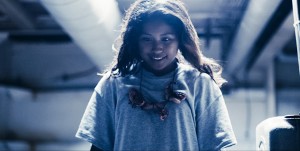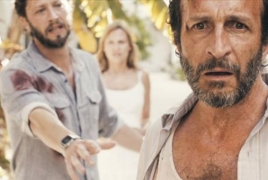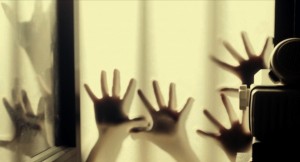 There are a select few directors that somehow manage to wrap themselves up so deeply in their films that one is forced to criticize them right along with their film. Typically most effective criticism largely divorces creator and content, and looks at each film as an effort of the filmmaker rather than, say, an appendage of the filmmaker. When you’re Quentin Tarantino making an extended cameo with the film’s most transgressive dialogue coming out of your mouth though, or Lars Von Trier with his massive title cards, character posters featuring himself, and outrageous statements to sell the movie, then you’re talking about directors that make it much harder to separate art from artists.
There are a select few directors that somehow manage to wrap themselves up so deeply in their films that one is forced to criticize them right along with their film. Typically most effective criticism largely divorces creator and content, and looks at each film as an effort of the filmmaker rather than, say, an appendage of the filmmaker. When you’re Quentin Tarantino making an extended cameo with the film’s most transgressive dialogue coming out of your mouth though, or Lars Von Trier with his massive title cards, character posters featuring himself, and outrageous statements to sell the movie, then you’re talking about directors that make it much harder to separate art from artists.
The key factor here is that these directors earned their notoriety by making subversive, interesting, and beautiful work that deserves to be examined- there is always plenty of spotlight to spare. The unfortunate thing is that when you’re a debut feature film director and you attempt to ape the same kind of stunt acts of egotism when your movie is a great big boring piece of shit, the effect is not the same.
Perhaps director Makinov –who will only appear publicly in a mask with a distorted voice– has engineered this to be the case, but his remake of Who Can Kill A Child? is so worthless that one can’t help but focus as much on his achievement in douchebaggery as the film itself. Normally the best path would be to simply ignore the film and its gaudy, tacky filmmaker, but since the movie is so worthless, one can be confident that this great big mess is all just going to fade anyway.
Come Out And Play is a virtually beat-for-beat remake of Luis Peñafiel’s 1976 horror film which, if not a classic, is definitely a noteworthy oddity. An adaptation of a (pre-Children of the Corn) novel, the film pits a vacationing, pregnant English couple (Franics and Beth in the remake) against an island of children that have simultaneously risen up to murder all adults around them. The story is a tragic one that ultimately goes to dark places and ends with a Romero-like sense of doom and apocalypse. Though primitive, it’s an effective horror film and features a lot of subtle beats that enhance the creepiness of the concept. It is admittedly a ripe property for a remake as there are certainly new levels it could be taken too, and new ideas, twists, and horrors that could be explored in the reflection of our times now.
 Makinov’s remake however, dispenses with whatever subtleties there were and instead plods along through the exact same story, relying on digital handicam and modern effects to give it a new life. Nothing fresh is explored while, in fact, a great deal of meaty subtext is completely ignored. With the choice to maintain such fidelity to the original source should come invention in staging and execution, but the film is blocked incompetently and written like virtually every trite horror film you’ve ever seen. Even with most of the film only featuring two main characters and an additional child or survivor here and there, Makinov still fails to stage some scenes coherently and writes typically lame-brained character beats that has the couple separating at points that any reasonable human beings would do just the opposite. There is even a scene when the two of them run across a horrible act of violence, and in the frenzy surrounding it one of them simply disappears from the scene.
Makinov’s remake however, dispenses with whatever subtleties there were and instead plods along through the exact same story, relying on digital handicam and modern effects to give it a new life. Nothing fresh is explored while, in fact, a great deal of meaty subtext is completely ignored. With the choice to maintain such fidelity to the original source should come invention in staging and execution, but the film is blocked incompetently and written like virtually every trite horror film you’ve ever seen. Even with most of the film only featuring two main characters and an additional child or survivor here and there, Makinov still fails to stage some scenes coherently and writes typically lame-brained character beats that has the couple separating at points that any reasonable human beings would do just the opposite. There is even a scene when the two of them run across a horrible act of violence, and in the frenzy surrounding it one of them simply disappears from the scene.
Writer and director Makinov also credits himself as the Director of Photography, which lays the often technically inept filmmaking at his feet. Bad focus pulling and lamely shot scenes do not a great pair make. Even the cheap attempt at standard horror scares fall flat, which punts all potential of the film being memorable to the violence and meaner stuff.
Unfortunately there’s not much enjoyment to pull from that either, as the violence is toothless and usually just out of frame. On the occasion the film does show something terrible, it’s shot exclusively as a tight crop on a kid doing something that looks like it’s probably bad, and then a wide of whatever it is they’re doing. It’s incessant, and the montage that contains the vast majority of whatever “horror” is in this film is painful to watch; “Hey, those kids are bouncing something around below frame. Oh, it’s a head. Hey, that kid’s playing with something on strings off screen! Oh, it’s a necklace of ears. Hey that girl is stabbing something below frame! Oh, it’s a mutilated body.” Over and over and over. Even the most twisted act of the film is dragged down by some very painful acting, and the lack of a creepy set up earlier in the film.
By the time the film finally rolls up its sleeves to get into some ugly child violence with actual gore, it’s so brief and plainly shot that it does nothing to save this slog of a horror film. Even the most base “rah rah violence!” horror fan is only getting about two or three minutes of enjoyment out of this thing.
Again, this would all just represent a run-of-the-mill horror film disappointment, except that the Fantastic Fest screening of the film features an attached “manifesto” from the director. A clumsily shot video of the director –in his mask of course– ranting into a camera in the woods about people and their dumb Facebooks, and how his intent with the film is to remind us “that we are all made of blood” and that horrible things are constantly happening. He stomps a cellphone while going on as if reading the blustering, angsty posting of a teenager on a message board. By the way, Makinov has a twitter account.
 It’s embarrassing enough before the film rolls by without an ounce of actual transgression or novel horror, and thinking back on it afterwards it becomes a true act of delusion. Still, a likely festival-only pre-show isn’t Makinov’s only act of raging ego. Like a two-bit Von Trier, Makinov makes sure his credits are large and screen-filling, with his final director’s credit literally stamping onto the screen, letter-by-letter, in a great big Funny Games red typeface. It’s nakedly obvious that his goal is to manufacture the kind of mystique ond outrage that, granted, a review like this contributes to, but fortunately his work is so tame and forgettable that it’s not likely to get much traction.
It’s embarrassing enough before the film rolls by without an ounce of actual transgression or novel horror, and thinking back on it afterwards it becomes a true act of delusion. Still, a likely festival-only pre-show isn’t Makinov’s only act of raging ego. Like a two-bit Von Trier, Makinov makes sure his credits are large and screen-filling, with his final director’s credit literally stamping onto the screen, letter-by-letter, in a great big Funny Games red typeface. It’s nakedly obvious that his goal is to manufacture the kind of mystique ond outrage that, granted, a review like this contributes to, but fortunately his work is so tame and forgettable that it’s not likely to get much traction.
The takeaway from all this is that you need to see the original film, which was incredibly difficult to find only a few years ago, but is now more accessible. It’s a little gem of a 70s horror film, and well worth your time. Come Out And Play meanwhile is a trifling embarrassment, am impetuous nothing of a horror film from a director I can only hope will either disappear, or shut up and put up if he tries again.
Rating: 




Out of a Possible 5 Stars